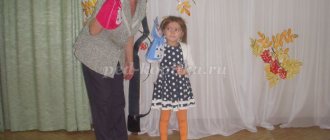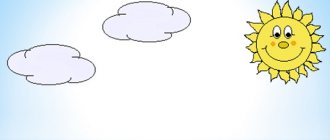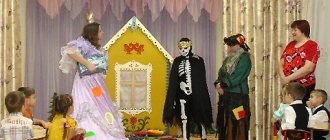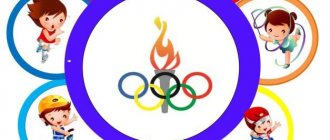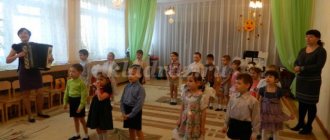Entertainment (musical leisure) for children of middle preschool age “Handkerchiefs”
handkerchiefs
Entertainment for middle preschool age
Musical director: Borodin M.V.
Target:
development of imagery and plasticity of movement to music.
Tasks:
- developing skills in various interactions with the scarf as a dance attribute;
- formation of ideas about the different nature of music and ways of expressing it through movement;
— development of fine and gross motor skills;
- development of auditory attention;
— development of communicative interaction with other children in the group;
- fostering a friendly attitude towards the creative manifestations of other children;
- fostering a respectful attitude towards the choices of other children.
Progress of the event:
- Finger game
(to the tune of the poem “Whether in the garden or in the vegetable garden”)
:
Our pen is like a handkerchief. Soft brush strokes
Wave to me, buddy!
I'll shake my handkerchief freely
And I’ll start waving again. Soft brush strokes
- First with one hand
- Then with the other hand
- With two hands:
Our hands are like handkerchiefs. With two hands, soft strokes of the brush
Let's rock them, my friends. We swing our arms above our heads
We shake our handkerchiefs, shake our brushes freely
And let's go play with you! Clap your hands 4 times
- Game "Big and small handkerchiefs"
The teacher invites the children to feel like handkerchiefs.
Music A (slow and smooth): the teacher and children walk freely, move widely, like large scarves - smoothly, leisurely moving their arms, shoulders, body, maybe their legs - free improvisation of movements, supported by the teacher’s demonstration. You can first show a large scarf and how it moves.
Music B (fast and easy): easy running in a free direction.
- Finger exercise “Gather a handkerchief into a fist”
Children sit in a circle and receive scarves of the desired color.
As the teacher demonstrates, the children gather each handkerchief into their palms with their fingers, starting from the corner, so that it all fits in their fist. Pieces of the scarf should not stick out from the fist. At first, the child can help himself with the other hand, but then he must learn to perform this exercise with one hand. The exercise game is carried out first with one hand, then with the other.
- Breathing-tactile exercise “Handkerchief – flower”
Children, as shown by the teacher, collect crumpled handkerchiefs into closed, clasped palms. Then they slowly begin to open their palms. The scarves, slightly released, are formed on open palms in the form of flowers.
· Inhale the aroma of these “flowers” and exhale slowly.
· Inhale the aroma of flowers and exhale with a sigh “Ah!”
· They do it like different animals: saying “Ah!” thin, like a mouse, low, like a bear, affectionate, like a cat.
· They inhale the scent of flowers and sneeze like puppies.
- Dance “Who has a handkerchief in his hands”
Russian folk melody, lyrics. A. Anufrieva (Kaplunova I., Novoskoltseva I. A holiday every day. Notes of music lessons with audio application. Middle group. - St. Petersburg, “Composer”, 2008, p. 54)
- Breathing exercises with paper tissues
The teacher exchanges the children's cloth scarves for multi-colored paper ones.
- The teacher and children sit in a circle. Holding the handkerchiefs by the corners, the children, as shown by the teacher, exhale on them so that they fly up.
- Everyone scatters. Place the handkerchiefs on your open palm and blow them away to the music. They pick it up and deflate it again.
- A game for auditory attention and alternating muscle activity and relaxation “We are handkerchiefs”
The teacher draws the children’s attention to how the paper handkerchiefs behaved now. The teacher asks the children to collect paper handkerchiefs and imagine themselves using them. “Music will breathe movement into us.” The teacher asks the children to run while the music is playing, imagining themselves as flying handkerchiefs, and when the music stops, lie down smoothly, like a paper handkerchief, on the carpet and not move. If necessary, the teacher discusses with the children what to do in order not to move - to relax the muscles. The teacher can walk around the hall in silence and check whether the muscles are well relaxed, lifting the arms and legs: they should fall freely, dangle with slight shaking.
- Relaxation to music
Children lie on the carpet in free positions. At the end of the relaxation, you can discuss what they “saw” while listening to this music.
- Game “Pass the handkerchief”
Children stand in a circle. 1st part of the music (smooth and leisurely): on the downbeat, they pass the handkerchief to each other in a circle.
Part 2 of the music (moving, cheerful): the child who has a scarf in his hand goes to the center of the circle and dances with it, the rest of the children clap.
The game is played several times.
- “Find a Pair”
Half of the children have scarves, the other - without. The children’s task is to make pairs for the first part of the music with 1 handkerchief between them.
After this, you can perform any pair dance.
- “Find your color”
Part 1 of music: children walk among the handkerchiefs, stand next to the one they like.
Part 2 of the music: take a handkerchief and form round dances with handkerchiefs of the same color.
Part 3 of the music: they dance, say goodbye, mix, leave handkerchiefs on the floor and form a general round dance without handkerchiefs (to repeat the game).
Part 3 of the music: they dance, say goodbye, mix and form a general round dance with handkerchiefs (to end the game).
- Game "Handkerchiefs are dancing"
Children again receive cloth handkerchiefs and sit in a circle. Small musical fragments of different nature are played. The scarves “dance” in different ways to change the music. Children control the scarves themselves, focusing on the nature of the music and the teacher’s demonstration.
Then the teacher and children rise to their feet. They throw scarves to the music and catch them.
- Parting.
Waving their handkerchiefs, the teacher and children sing to each other: “Goodbye!”
Musical leisure in the middle group “Sparrow went to the fair”
MBDOU "Childhood"
structural unit "Krasnoseltsovsky kindergarten"
Sparrow was going to the fair.
Musical leisure in the middle group.
Musical director: Repina I.V.
Purpose of the event
: enriching children with joyful experiences.
Tasks:
emotional development of children; developing communication skills with adults and peers; consolidation of knowledge about noise musical instruments.
Attributes
: carriage, toy horse, shirt and cap for Sparrow; hats of Foxes, Bears, Squirrels, Bunnies; chest; drums, sticks, wooden spoons, bells; screen with a painted forest.
There is a carriage in the hall. The role of Sparrow is played by a child. The horse is a toy. There is a screen on the side with a forest painted on it.
Leading
: Hello, dear viewers. Our children, although not very big, just an average group, already know some musical instruments and can play them. Look here. Listen and watch a fairy tale, but not just a fairy tale, but a musical one. So let's begin.
M. Protasov's song from the musical fairy tale “The Road to the Mill” is played.
Sparrow comes out and puts the chest of tools on the cart. (Further all the actions of the heroes are in the text)
Leading
: Once upon a time there was a Sparrow. He loved to play musical instruments. Sparrow heard that there would be a fair in the neighboring village. And the fair is music and fun. And so Sparrow decided to take musical instruments to the fair for music and fun. He put them in the chest and loaded it onto the cart. He sat on the cart, drove through the forest, listened to the birds. (A recording of the sounds of the forest plays.)
Sparrow dozed off. And the cart jumped on the bump! The chest fell out of the cart. (move the chest to the floor) The sparrow moved on, but the chest remained on the road. (cover the cart with a screen on which a forest is drawn)
Here are the bunnies jumping through the forest. They saw a chest, opened it, looked - there were tools there. Oh, what ringing drums are here! The bunnies took the drums and began to play them.
The r.n.m. sounds, the bunnies beat on the drums
. (“Dance of the Bunnies”, collection “Holidays and Entertainment in Kindergarten”, 1982)
Leading
: We heard Squirrel’s music and came running. They looked into the chest and took the sticks. Knock-knock, how loudly the sticks knock!
The phonogram “Children's Polka” by Zhilinsky plays
(program “Ladushki”, preparatory group, disc 1, No. 14).
The squirrels are knocking.
Leading
: I heard the music of Misha the Bear and decided to watch it. Yes, not alone, but with a bear and a bear. We looked into the chest, and there were painted spoons, so funny. So the Bear and the Bear began to play on spoons, and Mishutka began to dance.
R.n.p. “In the city of Misha” (collection “Let's play, let's dance”)
Leading
: “What kind of fun is that,” thought the Fox. She came running, looked in the chest and really liked the bells! She took it and began to play on them.
The song “Merry Bell” by V. Kikta is played, Lisa plays the bell
.
(remove the screen)
Leading
: Sparrow woke up from the music in the forest. He looks, but there is no chest. We need to go back and look. (rearrange the horse)
“The Road to the Mill” sounds, Sparrow “rides.”
Leading:
Sparrow looks: here is his tool chest! He picked him up, put him on the cart and went to the fair.
Here, guys, are the instruments we showed you (shows, the audience names) And now let’s all play together.
Musical game with the audience “Orchestra” (phonogram of the song “The Good Master in the Glorious Fairy Tale ...”)
